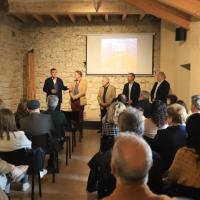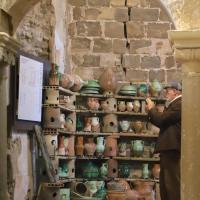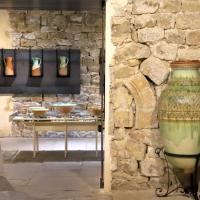Encuentro singular
EXPOSICIÓN
La poética del fuego y la tierra
Revivir de un horno árabe
The poetics of fire and earth.
Reviving an Arabic kiln
Organiza
Factum Foundation
Alfarería Melchor Tito
Fundación Huerta de san Antonio
Las excepcionales piezas cerámicas de esta muestra son el resultado de un ilusionante proyecto: volver a darle vida a un horno de tradición hispano-morisca de la ciudad de Úbeda. Después de permanecer más de dos décadas apagado, y tras año y medio de arduo trabajo, al fin fue posible realizar la hazaña, en una noche de luna llena, entre el 29 y el 30 de septiembre de 2023. En el vientre del antiguo horno árabe, el fuego y la tierra se aliaron para, en 36 horas, dar a luz más de 4.000 piezas con una personalidad única.
El proyecto, no solo pretende revivir la ancestral tradición alfarera de la ciudad, sino que también posee un enfoque contemporáneo e innovador, al actualizar y traer al presente todo ese bagaje de técnicas y conocimientos atesorados durante cientos de años.
Por otro lado, la iniciativa quiere aportar un registro exhaustivo de todo el proceso de creación de tan extraordinarias piezas cerámicas, a través de un corto documental producido por Factum. Cómo, desde que surgen de una simple pella de barro, tras recibir el baño de color con tierras y óxidos tradicionales, son minuciosamente decoradas y esmaltadas, para ser sometidas al proceso de cocción.
INGLÉS
The poetics of fire and earth
Reviving an Arabic kiln
The exceptional ceramic pieces of this exhibition are the result of an exciting project: to bring a Spanish-Moorish kiln from the town of Ubeda back to life. Having not been fired for more than two decades, and after one and a half years of hard labour, it was finally possible to perform the feat, on a full moon night, between 29 and 30 September 2023. In the belly of the ancient Arab kiln, fire and earth allied to give birth to more than 4,000 pieces, each with a unique personality, over 36 hours.
The project not only aims to revive the ancient pottery tradition of the town, but also takes a contemporary and innovative approach by updating and bringing to the present this heritage of techniques and knowledge accumulated over hundreds of years.
The initiative also seeks to provide an exhaustive record of the entire process of creating such extraordinary ceramic pieces, through a short documentary produced by Factum. The aim was to show how, arising from a simple lump of clay, objects are meticulously decorated and glazed, after receiving their colour bath with traditional soils and oxides, and before undergoing the firing process.
Melchor Tito, tradición alfarera
Los grandes protagonistas de este proyecto son la familia alfarera Melchor Tito, herederos durante generaciones de un oficio milenario en la ciudad de Úbeda. Guardianes del mítico horno árabe al que han conseguido despertar a la vida tras un largo periodo de letargo.
Atrás quedan muchos meses de trabajo y dedicación, en los que Melchor Tito y su hijo reunieron miles de piezas para rellenar el horno. Piezas moldeadas, enasadas, raídas, caladas, bañadas y decoradas. Y una muy especial: la tinaja árabe, decorada en grabado tradicional y esmaltada de color blanco de Úbeda, con óxidos de cobre y cobalto. Todas ellas, esperando el crítico momento de la cocción con técnicas utilizadas durante cientos de años.
Melchor Tito, pottery tradition
The Melchor Tito, family of potters, are the main protagonists of this project. Heirs for generations of an ancient craft in the town of Ubeda, they are the guardians of the mythical Arabic kiln that they managed to awaken after a long period of slumber.
The firing of the kiln was the culmination of many months of work and dedication during which Melchor Tito and his son created thousands of objects to fill the oven. Pieces that were moulded, stacked, scraped, carved, glazed and decorated. And a very special one: the Arabic tinaja, a jar decorated with traditional engraving and glazed in Ubeda white, with copper and cobalt oxides. All of them awaiting the critical moment of the firing with techniques used for hundreds of years.
Destacado: Rachid Koraïchi
Rachid Koraïchi, la gacela revisitada
El artista Rachid Koraïchi no duda en unirse a este proyecto, ya que su obra está en diálogo con las artesanías tradicionales. Trabajó durante semanas para pintar y decorar dos réplicas del famoso «vaso de las gacelas» de la Alhambra, pieza referente de la cerámica nazarí, que previamente había modelado en arcilla la familia Tito. Koraïchi, de origen argelino, es uno de los creadores más relevantes en el arte contemporáneo internacional. Formado en Argel y París, su obra se cimenta en la tradición y espiritualidad sufí, pero con un desarrollo moderno y universal, impregnado de poesía y lleno de referencias a la hermandad universal.
Rachid Koraïchi, the gazelle revisited
The artist Rachid Koraïchi did not hesitate to join the project, as his work is in dialogue with traditional crafts. He spent weeks painting and decorating two reinterpretations of the Alhambra’s famous “Gazelle Vase”, a reference piece of Nasrid ceramics, which had previously been modelled in clay by the Tito family. Koraïchi, of Algerian origin, is one of the most outstanding artists in international contemporary art. Trained in Algiers and Paris, his work is based on the Sufi tradition and spirituality, with a modern and universal development, imbued with poetry and full of references to universal brotherhood.
EL HORNO ÁRABE
Un legado milenario
El horno árabe es una construcción realizada con ladrillo refractario, de forma cuadrada en su base donde se prende el fuego, cilíndrica para colocar las piezas y cubierta por una cúpula de media naranja con troneras para la salida de los humos.
Se ha utilizado desde tiempo inmemorial para cocer los cacharros de barro, una vez se han moldeado en el torno, decorado y cubierto con capas de esmalte. Un proceso en el que los alfareros emplean varios meses de arduo y esmerado trabajo.
El horno es capaz de albergar en su interior miles de piezas, de distintos tamaños y formas, que deben ser colocadas con sumo cuidado, para evitar desperfectos y aprovechar al máximo el espacio. Una vez completada esta decisiva maniobra, se inicia su progresivo calentamiento, con la utilización de leña como fuente de energía. Hasta que llega el momento de «levantar el horno», avivando el fuego con caldas de orujo. El nuevo combustible que alimenta el fuego es el hueso de las aceitunas que debe arrojarse de forma constante durante veinticuatro horas o más, cuidando que las llamas se distribuyan de manera uniforme por toda la cámara del horno, hasta alcanzar el promedio deseado de los 1.000 ºC.
Es el momento, entonces, de sellar la boca con ladrillos, hacer la señal de la cruz pegando el barro en el muro y murmurar una jaculatoria: Que el Señor te quite lo que te sobra y te ponga lo que te falte. La suerte está echada, y ahora quedan cuatro largos días de espera e incertidumbre para el lento enfriamiento antes de poder abrir el horno y descubrir la sorpresa de su interior. Un sorprendente panorama de jarras, ollas, platos, alcuzas, lebrillos…, inmaculados y brillantes. Un mágico desfile de cerámicas excepcionales, únicas, tocadas de una bella imperfección, fruto de la poética conjunción del fuego y la tierra.
THE ARABIC KILN
A millennial legacy
The Arabic kiln is a construction made with refractory brick, square in shape at its mouth where the fire is lit, cylindrical where the pieces will be placed and covered by a semicircular dome with holes for the smoke to exit.
It has been used since time immemorial to fire the clay pots, once they’ve been moulded on the potter’s wheel, decorated and coated with layers of glaze. A process on which the potters spend several months of hard and painstaking work.
The kiln is capable of housing thousands of pieces of different sizes and shapes, which must be placed with great care to avoid damage and make the most of the space. Once this final manoeuvre is completed, the progressive heating of the kiln begins, with the use of firewood as the energy source. Until the time comes to “levantar el horno” (literally: “raise the oven”), stoking the fire with caldas de orujo (a pomice brandy). The new fuel that feeds the fire is olive stones, which must be thrown on it constantly for twenty-four hours or more, taking care that the flames are distributed evenly throughout the oven chamber, until the desired average of 1,000°C is reached.
Then, the time comes to seal the mouth of the oven with bricks, to make the sign of the cross by sticking clay on the wall and to whisper a short prayer: May the Lord take away what you don’t need and give to you what you lack. The die is cast, and now there are four long days of waiting and uncertainty for the slow cooling before the oven can be opened to unveil what is inside it. A delightful panorama of olive oil jugs, pots, dishes, bowls, all immaculate and bright. A magical parade of exceptional, unique ceramics, each with its own beautiful imperfection, the fruit of the poetic combination of fire and earth.
CRÉDITOS
Un proyecto impulsado por la Fundación Factum, la alfarería Melchor Tito y la Fundación Huerta de san Antonio. Con el asesoramiento de Marcelino Sánchez Ruiz.
A project led by Factum Foundation, Alfarería Melchor Tito and Fundación Huerta de san Antonio. With the advice of Marcelino Sánchez Ruiz.



